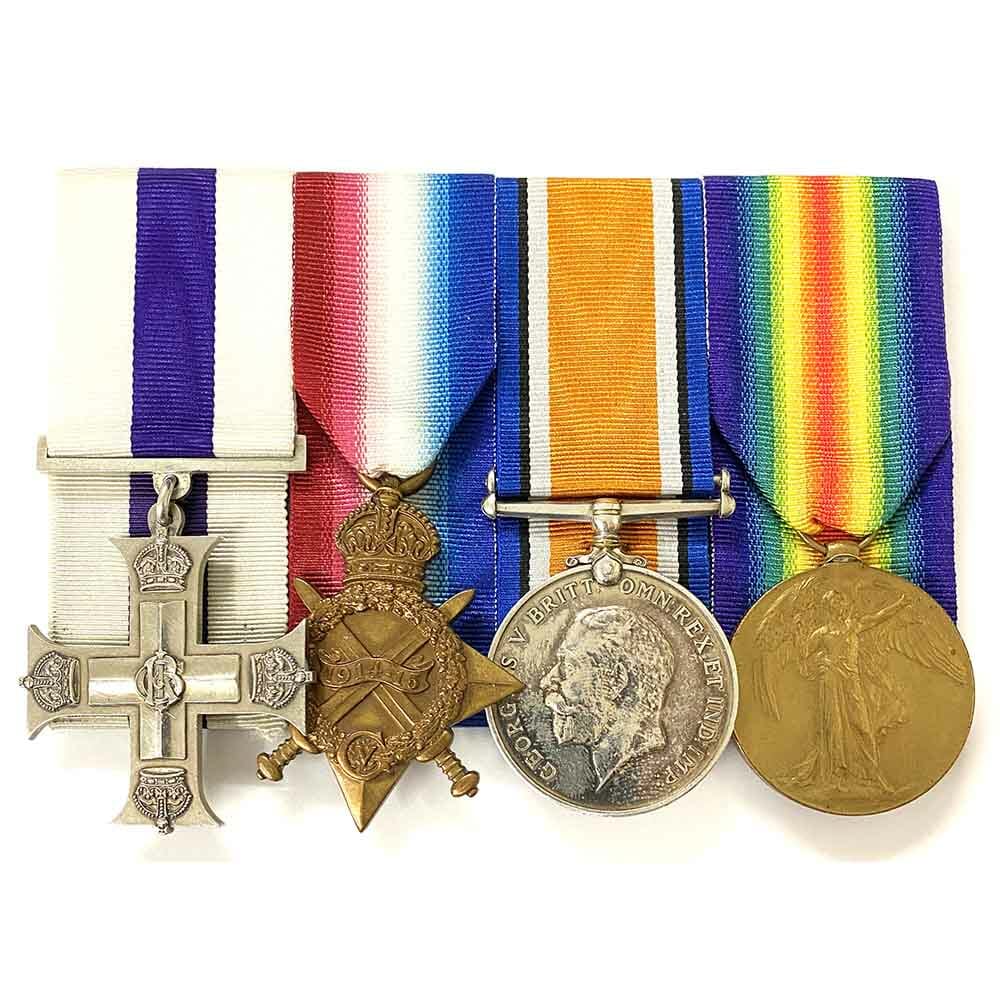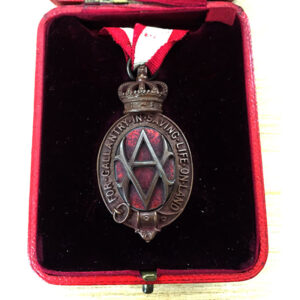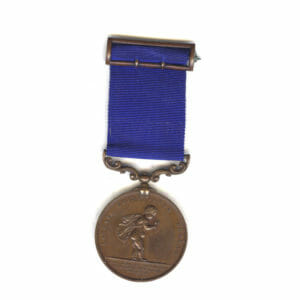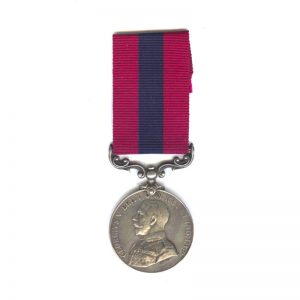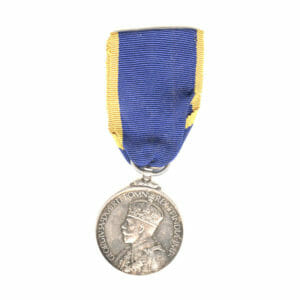Description
Military Cross, GV, 1914-15 Star, British War and Victory Medal, Lieut Legh Richmond Hutchison, 33rd Battalion, Machine Gun Corps, former Army Service Corps
1914-15 Star impressed: “2 Lieut L. R. Hutchison A.S.C.”
Pair impressed: “Lieut L. R. Hutchison”
Awarded the Military Cross in London Gazette 1st January 1919.
This Officer had the unusual honour of fighting alongside his twin brother, Major Graham Seton Hutchison, D.S.O., M.C. (Recommended for a Victoria Cross), during which time Legh earned his Military Cross for bravery, their rocky relationship is recounted in much detail in the Autobiography of Graham Seton Hutchison “Footslogger” published in 1933, including the action in which he would later earn this Military Cross.
The book can be read online for free at this link Online Archive of Footslogger, An Autobiography by Graham Seton
Legh Richmond Hutchison was born during January 1890 in Hampstead along with his Twin Brother Graham Seton Hutchison D.S.O. M.C., in a house known as Three Gables in Fitzjohn’s Avenue, Hampstead. He had a large extended family with signifiant civic and military traditions: his father James Alexander Hutchison held a leading position in one of the principal merchant banks in London and the family had been closely linked to the City of London for hundreds of years, supplying the city with four generations of common councillors, three generations of Aldermen, three Sheriffs and Two Lord Mayors. His father was also a noted Alpine Climber being the one of the first to climb the Matterhorn, these intense adventures however took a severe toll on his health leading to his early death aged 53, when Legh was only 6 years old.
The twins were then sent off to Boarding School at Heddon Court, where Legh prospered.
He first enlisted in the Territorial Force direct from the Inns of Court Officer Training Corps during December 1914.
He was then commissioned as 2nd Lieutenant in the Army Service Corps during March 1915 and entered the war in France by July as a member of No 3 Company, 19th Divisional Train A.S.C.
He saw action at Loos in September 1915 and on the Somme in 1916, after some brief service with the 1st Battalion, Hampshire Regiment before transferring to the Machine Gun Corps (Infantry).
His Twin’s Autobiography, “Footslogger” notes how Legh joined the Machine Gun Corps and has a wealth of information about the two of them.
Page 236:
“In the preceding May I had asked for the services of my twin brother as Transport Officer of the Battalion. He had come home from Buenos Aires and had gone over the top a few times with the 2nd Hampshire Regiment. But “Giglamps,” owning to astigmatism, could never have qualified as an efficiency infantry leader. So accidentally he found himself in the A.S.C. train of the 19th Division. He knew all about horses, and was of that temperament to be patient with the vagaries of the mule. I put him in charge of my Transport, in its strength of animals and vehicles equal to that of a whole brigade and more.
In our passage through the forest, I elected to drive my transport ahead of the Battalion on the tactical grounds that, if attacked, the gunners could come to the transport and thus get into action, whereas with only a single road, if the transport followed we should never be able to get them into action. My twin protested. I was quite cold-blooded in my suggestion. If what I had considered possible did in fact happen, the animals would be slaughtered in their traces. My Brother would not stand for that. He refused. I said to him ‘Are you speaking to me as a twin brother or as a Junior Officer?’, With greater speed than is his custom he snapped, ‘As a junior officer.’
I placed him under arrest. Then I telephoned to General Pinney to tell him what I had done.
Before we went into action, both my brother and I dined with the Divisional Commander. We both went into action together, but my transport, with a patrol screen of the 1st Middlesex, led the Division through the wood. and my twin was awarded the Military Cross.
On the 3rd November we assaulted. The Middlesex did great work with the Bayonet. in Hecq and on the edge of the forest there were rows of enemy dead piled behind fallen tree-trunks, bayoneted. In the road itself there were enormous craters which had been blown and immense obstacles formed by felled tree across the road. I sent forward my spare horses with traces and cleared the road head. then we came to the village of Locquignol. My band with its instruments was marching in the rear of the Battalion.
As we entered the main street of the village it was deserted. But the band struck up ‘La Marseillaise.’ Heads appeared at the windows, at first timidly and shyly, then old men, women, and children ran out into the streets. They must have been waiting for our advance for a woman ran out with a garland of flowers and placed it around my neck. I felt rather foolish, for they cheered and wept and kissed my old trench boots as I rode down the mains street. Then we passed on, still through the forest until we came to the line of the River Sambre. The Germans were sitting tight on the high ground on its eastern bank, after destroying the only bridge.
The report written by Capt F.C. Booth, V.C., D.C.M., commanding the leading Company of the Middlesex states:
“The advanced through Foret de Mormal during the early part of the 4th Instant had been very rapid and the Machine Gun Corps in this action had proved that their system of transport was so efficient that notwithstanding the fact that the Infantry had advanced almost as quickly as men could march, when the outpost line as checked and held up near the river bank, the Machine-Guns came into action immediately. It is doubtful whether, under the old system of fighting, the machine-guns with the Infantry Battalion, this could have been achieved… The whole of the Machine-Gun Battalion was in action on the enemy trenches early; and they kept up such an accurate fire that the infantry were able to choose their spot for building the bridge, and even to dump a large portion of the material required near the spot, that at dusk we were able to push our first bridge across the river which was unfordable, and establish a crossing….
The action was a great success and casualties were practically nil. The 33rd battalion Machine Gun Corps worked splendidly throughout these operations, thoroughly upholding the traditions of the British Army and adding another glorious victory to their splendid record, Their Commanding Officer should be a very proud man.”
And he was.”
His twin was none other than Graham Seton Hutchison, D.S.O. M.C., known by others as the “Mad Major”.
Also whilst Legh Hutchison was serving with the 33rd Battalion M.G.C., his twin had become Major and Commanding Officer of the battalion, who was a bit of a tactical genius in the way of combat, in 1917 he convinced his commanding officer to group all the machine gunners, who were at the time spread between four brigades, into a single company under his command, a scheme which was soon rolled out across the British Army resulting in the Machine Gun Corps becoming its own independent branch of the army.
He was also well known for his strong opposition to retreat and recounted a story of how in March 1918 he shot all but two of a group of 40 British soldiers fleeing from the German Army.
This led to the award of the Distinguished Service Order and Military Cross, followed by the composer Kenneth J. Alford, one of the finest composers of Marches for Band to compose the “The Mad Major” as a tribute to him.
